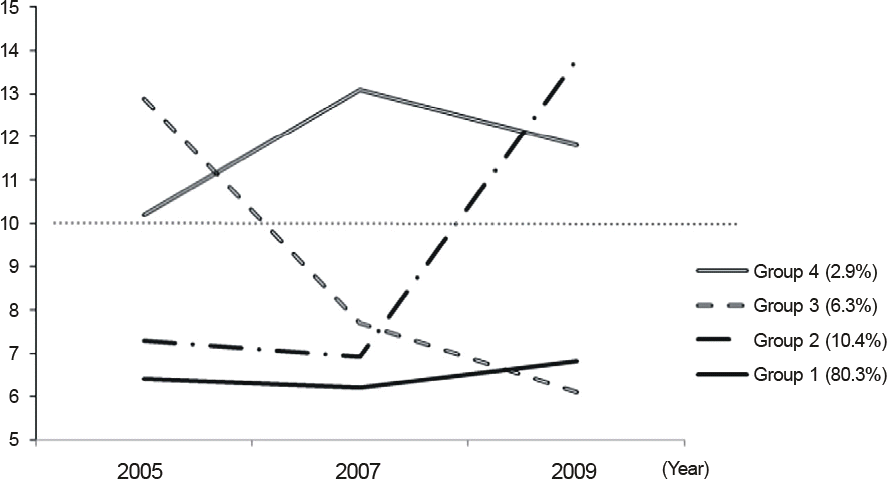Abstract
Background
Recent studies conducting changes in depressive symptoms among the elderly reported mixed results. The present study sought to determine if subgroups of elderly Koreans follow distinctive depressive symptom trajectories and the characteristics associated with the depressive symptom trajectories.
Methods
Subjects were those who had participated in a longitudinal study of quality of life in older adults. A latent class mixture model was examined to identify the trajectories of depressive symptom changes with time.
References
1. Lee HJ. Longitudinal changes in depression in older adults: differences across age groups and risk factors. J Welfare Aged. 2013; 61:291–318.
2. Harris AH, Cronkite R, Moos R. Physical activity, exercise coping, and depression in a 10-year cohort study of depressed patients. J Affect Disord. 2006; 93(1–3):79–85.

4. Spence NJ, Adkins DE, Dupre ME. Racial differences in depression Trajectories among older women: socioeconomic, family, and health influences. J Health Soc Behav. 2011; 52(4):444–59.
5. Jeon HS, Kahng SK. Predictors of depression trajectory among the elderly: using the Korean welfare panel data. J Korean Gerontol Soc. 2009; 29(4):1611–28.
6. Chiao C, Weng LJ, Botticello AL. Social participation reduces depressive symptoms among older adults: an 18-year longitudinal analysis in Taiwan. BMC Public Health. 2011 May 10; 11:292.

7. Hong SI, Hasche L, Bowland S. Structural relationships between social activities and longitudinal trajectories of depression among older adults. Gerontologist. 2009; 49(1):1–11.

8. Jeon HS, Dunkle RE. Stress and depression among the old-est-old: a longitudinal analysis. Res Aging. 2009; 31(6):661–87.

9. Lynch SM, George LK. Interlocking trajectories of loss-related events and depressive symptoms among elders. J Gerontol B Psychol Sci Soc Sci. 2002; 57(2):S117–25.

10. Nagin DS. Analyzing developmental trajectories: a semiparametric, group-based approach. Psychol Methods. 1999; 4(2):139–57.

11. Galatzer-Levy IR, Bonanno GA. Beyond normality in the study of bereavement: heterogeneity in depression outcomes following loss in older adults. Soc Sci Med. 2012; 74(12):1987–94.

12. Judd CM, McClelland GH, Ryan CS. Data Analysis: A Model Comparison Approach. 2nd ed. New York, NY:Rutledge;2009.
13. Radloff LS. The CES-D Scale: a self-report depression scale for research in the general population. Appl Psychol Meas. 1977; 1(3):385–401.
14. Jones BL, Nagin DS, Roeder K. A SAS procedure based on mixture models for estimating developmental trajectories. Sociol Methods Res. 2001; 29(3):374–93.

15. Andreescu C, Chang CC, Mulsant BH, Ganguli M. Twelve-year depressive symptom trajectories and their predictors in a community sample of older adults. Int Psychogeriatr. 2008; 20(2):221–36.

16. Byers AL, Vittinghoff E, Lui LY, Hoang T, Blazer DG, Covinsky KE, et al. Twenty-year depressive trajectories among older women. Arch Gen Psychiatry. 2012; 69(10):1073–9.

17. Kuchibhatla MN, Fillenbaum GG, Hybels CF, Blazer DG. Trajectory classes of depressive symptoms in a community sample of older adults. Acta Psychiatr Scand. 2012; 125(6):492–501.

18. Murphy BM, Elliott PC, Worcester MU, Higgins RO, Le Grande MR, Roberts SB, et al. Trajectories and predictors of anxiety and depression in women during the 12 months following an acute cardiac event. Br J Health Psychol. 2008; 13(Pt 1):135–53.

19. Taylor DH Jr, Ezell M, Kuchibhatla M, Østbye T, Clipp EC. Identifying trajectories of depressive symptoms for women caring for their husbands with dementia. J AM Geriatr Soc. 2008; 56(2):322–7.

20. Kim DB, Sohn ES. A metaanalysis of the variables related to depression in elderly. J Korean Gerontol Soc. 2005; 25(4):167–87.
21. Andresen EM, Malmgren JA, Carter WB, Patrick DL. Screening for depression in well older adults: evaluation of a short form of the CES-D (Center for Epidemiologic Studies Depression Scale). Am J Prev Med. 1994; 10(2):77–84.
22. Cho MJ, Kim KH. Use of the Center for Epidemiologic Studies Depression (CES-D) Scale in Korea. J Nerv Ment Dis. 1998; 186(5):304–10.

23. Folstein MF, Folstein SE, McHugh PR. "Mini-mental state". A practical method for grading the cognitive state of patients for the clinician. J Psychiatr Res. 1975; 12(3):189–98.
24. Kang YW. A normative study of the Korean Mini Mental State Examination (K-MMSE) in the elderly. Korean J Psychol. 2006; 25(2):1–12.
26. Kim DB, Park SY. Characteristics of social network and suicidal ideation: verifying of mediation effect of depression. Korean J Soc Welfare Res. 2010; 24:109–29.
27. Kim SY, Jang YE. The influence of marital satisfaction on the suicidal ideation of the elderly: focusing on mediating effect of depression. J Korean Gerontol Soc. 2011; 31(2):305–19.
28. Seomun JH, Lee HA. A study on influence of subjective health recognition and social support on the elderly suicide ideation: using parameter effect of depression. J Welfare Aged. 2011; 54:361–85.
29. Statistics Korea. Cause of death. 2011. [Accessed November 10, 2012].http://jah.sagepub.com/content/22/1/84.short.
Table 1.
Review of previous studies on depression trajectories in older adults
Table 2.
Comparisons of depressive trajectories using demographic, health-related, social informationa,b
Table 3.
Results of predicting the likelihood of falling in group 2, group 3, and group 4 compared to group 1a




 PDF
PDF ePub
ePub Citation
Citation Print
Print



 XML Download
XML Download